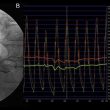Original Title: Utilization and 1-Year Mortality for Transcatheter Aortic Valve Replacement and Surgical Aortic Valve Replacement in New York Patients With Aortic Stenosis2011 to 2012. Reference:Hannan EL et al. J Am CollCardiolIntv. 2016;9(6):578-585. Courtesy of Dr. Agustín Vecchia It’s been only 14 years sinceCribierperformed the first transcatheter valve replacement. Today, during 2016, 100,000 patients are expected to...
The Effect of Age in Patients with Triple Vessel CAD Undergoing PCI vs. Surgery
Original Title: Effects of Age and Sex on Clinical Outcomes after Percutaneous Coronary Intervention Relative to Coronary Artery Bypass Grafting in Patients with Triple Vessel Coronary Artery Disease. Reference: KyoheiYamaji et al. Circulation. 2016 Mar 23. [Epub ahead of print]. Sex and age are factors that are often considered in the daily practice to decide...
HOPE 3: Reducing LDL Improves Prognosis in Intermediate Risk Patients
In a large cohort of intermediate risk patients with no known CAD, treatment with low doses of statins in addition to an angiotensin receptor blocker and a diuretic, reduce the risk of cardiovascular events, compared to placebo. These are the main findings of the HOPE 3 trial (Heart Outcomes Prevention Evaluation) that randomized 12705 patients,...
Less Paravalvular Regurgitation and More Pacemakers for the New Balloon Expandable Valve
Original Title: Changes in the Pacemaker Rate After Transition from Edwards SAPIEN XT to SAPIEN 3 Transcatheter Aortic Valve Implantation. The Critical Role of Valve Implantation Height. Reference: Fernando De Torres-Alba et al. J Am CollCardiolIntv. 2016, online before print. The aim of this study was to analyze pacemaker implantation rates with the new generation...
Endoleaks Type II: no association with mortality
Original Title: Risk factors and consequences of persistent type II endoleaks. Reference: Ruby C. Lo et al. J Vasc Surg 2016;63:895-901 The presence of type II endoleaks is infrequent (1%-10%) and most cases resolve spontaneously at 12 months. When they don’t, there is still controversy as to whether they may be associated to aneurysm diameter...
Mechanisms of Very Late DES Thrombosis by OCT
Original Title: Mechanisms of Very Late Drug-Eluting Stent Thrombosis Assessed by Optical Coherence Tomography. Reference: Masanori Taniwaki et al. Circulation. 2016 Feb 16;133(7):650-60. The physiopathological mechanisms behind DES thrombosis have not been fully described yet. The potential causes behind this adverse event were assessed using optical computed tomography (OCT). Between August 2010 and December 2014,...
In Bifurcations, less is more, also at long term
Original Title: Optimal Strategy for Provisional Side Branch Intervention in Coronary Bifurcation Lesions3-Year Outcomes of the SMART-STRATEGY Randomized Trial. Reference: Young Bin Song et al. J Am CollCardiolIntv. 2016;9(6):517-526. This study compared the long term outcomes of the conservative strategy vs. the aggressive strategy for provisional side branch intervention in coronary bifurcations. It has already...
Is normal FFR always good prognosis?
Original Title: Coronary Flow Reserve and Microcirculatory Resistance in Patients with Intermediate Coronary Stenosis. Reference: Joo Myung Lee, el al. J Am Coll Cardiol 2016; 67:1158-69 Courtesy of Dr. Carlos Fava. Measuring fractional flow reserve (FFR) helps establish whether intermediate stenosis will generate ischemia, but it won’t help assess microcirculatory function. It has been shown that...
High bleeding risk: is BMS still justifiable?
Original Title: Is Bare-Metal Stent Implantation Still Justifiable in High Bleeding Risk Patients Undergoing Percutaneous Coronary Intervention? A Pre-Specified Analysis From the ZEUS Trial. Reference: Sara Ariotti et al. J Am Coll Cardiol Intv. 2016;9(5):426-436. This work studied ischemic and bleeding events in high bleeding risk patients randomized to the zotarolimus eluting stent (ZEZ) Endeavor...
Vorapaxar in Acute Limb Ischemia
Original Title: Acute Limb Ischemia and Outcomes With Vorapaxar in Patients with Peripheral Artery Disease: Results From TRA2°P-TIMI 50. Reference: Marc P. Bonaca et al. Circulation. 2016 Mar 8;133(10):997-1005. Patients with peripheral artery disease have a high risk of acute limb ischemia, an event that may result in the loss of the affected limb. This...









